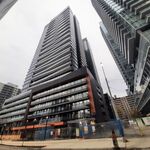The name sounds beautiful, but the first time I went to Queens Quay, I was not able to locate it, as it is so easy to miss. You can easily walk by it without realizing it is just on your left hand side. The name evokes imagination such as the Sydney Opera House, or something more realistic and less glorious, the Canada Place in Vancouver. but in reality, the Toronto Harbourfront center is really some two (or three?) storeyed structure that holds no architectural value or even pleasing to the eye. It looks like any community center - the St Jamestown community center looks nicer than it, or a primary school in Thunder Bay, yet occupying a large space and the best location in Toronto.
I don't know its history. Maybe at the time it was built, Toronto never had any vision or desire to be a great or just nice looking city, and just want to be a mediocre lake side town, thus allowing such structures -- I can't say ugly, it is just no one will never notice or remember how it looks like -- to be built there and name it "Harbourfront Center".
We can talk about the vibrancy or how many cultural activities happening by the lake in the summer any way we want, but the Harbourfront Center essentially represents the ultimate mediocrity when it comes to Toronto's waterfront planning and design. It is like, we need a center to hold events, why not ask a cheap builder to put some concrete and drywalls on Queens Quay, name it "Hourbourfront Center" and call it a day. Has anybody ever cared the beauty of our city?
It does echo nicely with the old condos on the other side of Queens Quay.
Queens Quay needs a lot of work, but nothing will change if the Harbourfront center doesn't.
The 1970s were a time when Toronto knew exactly what it wanted. This was the Jane Jacobs and David Crombie reform era. Toronto wanted heritage preservation, view corridor preservation, pedestrian-oriented urban design, vibrant streets as opposed to overhead walkway sterility, and architecture that encapsulated all these goals above all. Toronto, like other major world cities, was increasingly sceptical of bold Modernist design that called for the demolition of meaningful heritage buildings, produced windswept plazas, blocked views, resulted in sterile public spaces meant to discourage loitering, and saw crime in the deadzones around Modernist buildings.
This movement reflected international trends, and it's very common to find projects reflective of these new reform values in every major European and North American city that was successful at the time, prioritizing projects that fit into the traditional city or negotiated between tradition and Modernism. The pedestrian zones in many European cities often date to 1970s, and Toronto saw a part of Yonge pedestrianized in this era as well. Architecture often became more deferential and less inclined towards boldness, except for Brutalism. That's where Harbourfront fits in. At that point, interesting old industrial buildings where preserved and converted as opposed to being demolished without a second thought. To offer all this culture on a reimagined, post-industrial waterfront downtown with clear links to the past while being contemporary was quite progressive.
We've seen beautiful architecture in Toronto since its early days in the 19th century, but by 1970s, the city was strongly in line with international urban design and architectural movements, and recognized as a leading city in Modernist reform. In retrospect, it must have been an inspiring time because a greater sense of consciousness was being formed in the city in terms of history, historic architecture, culture, the merits of the walkable, pedestrian-oriented city, historic views, mixed-use development, and even cycling. It's perverse to hear Harbourfront Centre described as a product of a less ambitious city because it's really the opposite. Harbourfront Centre itself features the Amsterdam Bridge, a pedestrian bridge whose name commemorates the partnership of Toronto and Amsterdam in 1974, the kind of partnership which would be characteristic of the ambitious Toronto of the 1970s. (Amsterdam commemorated the partnership with some Toronto-named structures as well.)
yeah, I figured I would get responses like this. There has never been a shortage of excuses for the lack of good design among many folks here. We don't need it to look good, we only need it to work (and yes, it works better than anywhere else)! If you want to look nice, you are by definition a bleached-blonde silicone bimbo with no content whatsoever. I guess Paris and Barcelona with their world class architectures are in your mind, just boring silcone implants. The more vehemently one protests against constructive criticism, the more insecurity it shows. Members like you can't handle any nagative comments about this city and only want praises like "first class", "most livable" "vibrant" "diversity".
Your criticism that it's possible to be beautiful and functional is sound, but Harbourfront Centre shows that the lack of bold beauty doesn't preclude a place from being interesting or relevant. In its historical context, we can understand its particular aesthetic. Toronto finds a lot of meaning and identity in this era. There was so much at stake in the 1970s in terms of confronting the problems with bold Modernism in Toronto and internationally that the deferential approach to architecture proved to be satisfying and reassuring to planners and architects in various cities around the world. They were regaining the control they needed to progress in the traditional city, rather than dubiously destroying and rebuilding. Harbourfront Centre is a great cultural centre with preserved but creatively repurposed architectural heritage, and it's a pleasant place to spend time.




